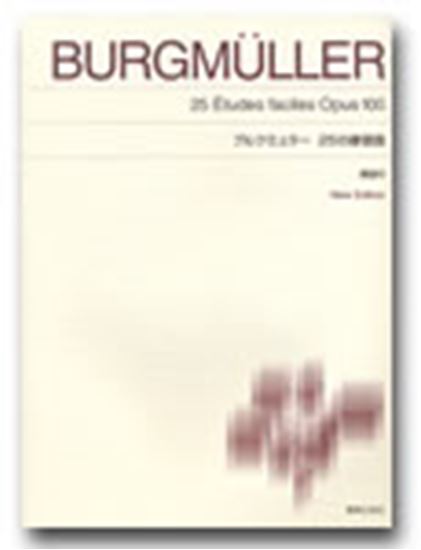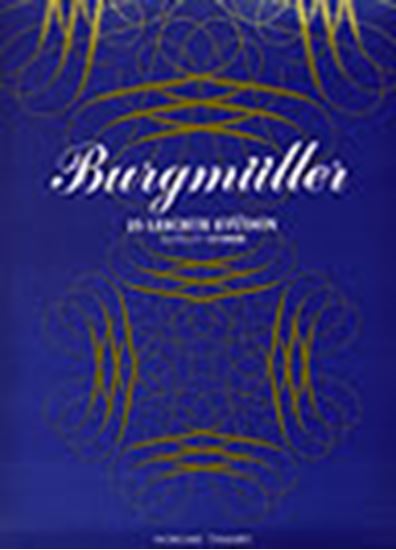Burgmüller, Johann Friedrich Franz : 25 Etudes faciles et progressives, conposées et doigtées expressément pour l'étendue des petites mains Consolation Op.100-13
Work Overview
Genre:etude
Total Playing Time:1 min 30 sec
Copyright:Public Domain
Additional Notes:表記ゆれの例: コンソレーション
Commentary (3)
Author : Sato, Takashi
Last Updated: January 31, 2022
[Open]
Author : Sato, Takashi
Perhaps it is comforting the sorrow of parting from the previous piece. Consolation is a famous title for piano pieces by Liszt, who also had a close relationship with Burgmüller. The term "lusingando" written at the beginning of the piece is sometimes explained in dictionaries as "coaxingly" or "flatteringly," but it rather carries the nuance of "gently caressing, soothingly accompanying." The cadence in the mediant key (E minor) at measure 15 is a bit unusual, but it is a harmonic progression characteristic of Burgmüller.
Performance Points (Original Tempo ♩=152)
- At the beginning, practice isolating the difficult-to-move 4th/5th fingers and 3rd/4th fingers while sustaining the 1st finger.
- From measure 8, practice playing the sustained 1st finger quietly so as not to disturb the melody in the upper voice.
- The "A - G - F# - G - A - G" from the latter half of measure 11 is also an accompaniment, so play it quietly.
- From measure 16, similarly with the left hand, and from measure 20, conversely, the 5th finger becomes the sustained note of the accompaniment.
- Play the entire piece legato and introspectively.
(From To-on Edition "Burgmüller 25 Etudes" (NS70))
Author : Iida, Arisa
Last Updated: March 15, 2018
[Open]
Author : Iida, Arisa
Musical example provided by: Ongaku no Tomo Sha
Author : Ooi, Kazurou
Last Updated: May 10, 2019
[Open]
Author : Ooi, Kazurou
Introduction
This piece is not technically very difficult, but it is musically very challenging. It is in a form close to binary form (two-part form), and the same material is repeated twice in both the first and second halves. Therefore, performers must be careful to avoid a flat performance. This will be discussed later.
Please consider that it is basically composed of three materials. And the key point is to differentiate these three materials in performance (to make them sound like distinct materials to the listener).
The Three Materials
- First Material: The whole-note chord starting on the first beat of measure 1. Although it becomes less apparent in the latter half, long notes of half-note duration or longer should be considered accompaniment chords.
- Second Material: The eighth notes starting on the upbeat of the first beat in the treble clef of measure 1.
- Third Material: The melody line written in quarter notes, starting on the second beat of measure 8.
Detailed Explanation with Examples
Let's examine each with examples.
Measures 1-5: Only the first and second materials are present. At this point, ensure that the highest note of the first material—for example, the whole note G in measure 1, H in measure 3, or C in measure 4—is not confused with the second material. The notes that should be heard by the listener in measure 1 are DEDEDED, not GDEDEDED. To prevent the first material from sounding like part of the second material, apply a dynamic difference, playing the whole notes at ppp and the eighth notes around mp. This will make these materials sound distinct to the listener. Proceed similarly thereafter.
The third material, the melody line, appears from measure 8 (strictly speaking, there is a similar material in measure 7). Naturally, a clear distinction must be made between the quarter notes of the melody line and the eighth notes written in the same treble clef. In particular, the G note, which functions as a pedal tone, is played with the first finger, isn't it? Since the first finger is the strongest, there's a tendency to play it too loudly. Suppress its volume significantly to differentiate it from the melody line. Conversely, the melody line must stand out most clearly among the three materials.
However, following this melody line reveals an inconsistency. The quarter notes of the melody line conclude at measure 13. Yet, it's a rather un-conclusive ending, isn't it? Therefore, although not written in quarter notes, the HAisHC HAGFis in measure 14 should be considered part of the melody. The same applies to measure 15, but in measure 15, the upbeat H should be considered a pedal tone (part of the second material), and only EGE should be played clearly.
Now, measures 16-23 are identical to measures 8-15, not differing by a single note. Exactly the same events occur. The challenge for the performer here is how to differentiate these two sections. You must devise a way to avoid playing these two sections exactly alike. While you should consult your teacher for specific ideas, examples include differences in dynamics or rubato. It's not about what's right or wrong, but simply ensuring that something is different, and that this difference is clearly conveyed to the listener. I believe this is the most difficult aspect of performing this piece.
The new melody in measure 24, which is the B section, concludes at measure 31. However, measures 32-38 are also exactly the same as measures 24-31 (with a slight difference from the third beat of measure 39, which becomes the coda). Even the dynamic markings are written identically. In this section too, you must differentiate the two identical sections (measures 24-31 and 32-38) by playing them differently in some way.
Pedaling
Finally, in measure 41, change the pedal on the first beat, the third beat, and additionally on the fourth beat. This is because the D-sharp on the upbeat of the third beat can cause muddiness. Since a ritenuto is present, even greater attention to pedaling is required.
PTNA & Partner Channel Videos(19items) View More
Sheet MusicView More
Scores List (24)

(株)東音企画(バスティン)

(株)東音企画(バスティン)

(株)東音企画(バスティン)

(株)全音楽譜出版社

(株)ドレミ楽譜出版社

(株)音楽之友社

KMP(ケイ・エム・ピー) ケイエムピー

(株)ドレミ楽譜出版社

ハンナ(ショパン)

(株)ヤマハミュージックエンタテインメントホールディングス

デプロMP

(株)ドレミ楽譜出版社

(株)全音楽譜出版社

(株)ドレミ楽譜出版社

カワイ出版

カワイ出版

デプロMP

(株)ヤマハミュージックエンタテインメントホールディングス

デプロMP

(株)音楽之友社

(株)共同音楽出版社

Neil A. Kjos Music Company



















